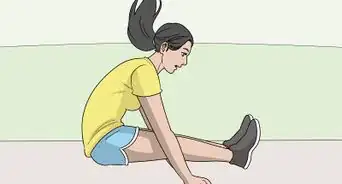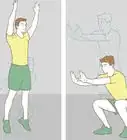This article was co-authored by wikiHow staff writer, Kyle Hall. Kyle Hall works on the content team at wikiHow. He helps manage our team of editors and creates content for a variety of wikiHow projects. Kyle continually looks for new ways to improve the content at wikiHow and make it more helpful and enjoyable for readers. He graduated from Eckerd College in 2015, where he majored in Political Science.
There are 7 references cited in this article, which can be found at the bottom of the page.
wikiHow marks an article as reader-approved once it receives enough positive feedback. This article received 13 testimonials and 84% of readers who voted found it helpful, earning it our reader-approved status.
This article has been viewed 309,329 times.
Learn more...
To win at the long jump, you'll need to jump farther than all of your opponents. The best way to do this is to train before the competition so you get faster and better at jumping and landing. You’ll also want to make sure you’ve mastered your long jumping form. Once you’ve got your form down, you can work on using long-jumping techniques that will help you increase the distance of your jump.
Steps
Training for the Long Jump
-
1Practice your approach with approach drills. Your approach (your sprint down the runway) will make a big difference in how far you end up jumping. You want to get up to speed in your first few sprints and then maintain your speed until you jump. Practice this by doing approach runs on a track. Don’t actually go through with the jump, just focus on getting up to speed and maintaining your velocity.
- Designate a take off spot on the track and then stop when you reach it. Go back to where you started after you finish and try again.[1]
-
2Do jumping drills. Practice doing jumps without the approach. Stand in place and bend your knees, placing one foot in front of the other. Bend your body so your upper torso is parallel with the floor. Hold your arms at your sides and extend them straight back so they’re also parallel with the floor. When you’re ready, lift your body and propel yourself into a jump. Raise both of your arms up and over your head. Land with both feet flat on the floor.[2]
- Each time you do the drill, mark where you landed. On your next attempt, try to beat your last mark.
Advertisement -
3Work on your landings. Find a long jump pit to practice in. Do a short 2-3 step approach down the runway and jump when you reach the takeoff board. Work on getting your legs up and out in front of you. You want your heels to be the first part of your body to make contact with the pit. Repeat the drill until you feel comfortable with your landings.[3]
Mastering Your Form
-
1Use your forward foot to push off at the start of the runway. Usually, this foot will be your non-dominant foot, but go with whatever is most comfortable for you. Lean forward at about a 45-degree angle as you start your approach.[4]
-
2Move into an upright sprinting position as you accelerate. After a few strides down the runway, your body should be horizontal and erect. Bend your arms at 90-degree angles[5]
-
3Lower your center of gravity on the second-to-last step before takeoff. Place your leading foot flat on the ground and flex your ankle and knee.[6]
-
4Don’t freeze on the last step. You want to continue accelerating as you go into the takeoff. Slowing down on the last step will ruin your momentum and shorten the distance you jump. As you take your last step before takeoff, briefly place your foot flat on the takeoff board.
-
5Push yourself into the air using your foot on the ground. This will be the foot you planted on the takeoff board. Remain upright as you jump. Swing your leading knee and the opposite arm into the air to increase your lift. Keep looking straight ahead.[7]
- Make sure your foot is flat on the ground as you jump. You’ll jump further off a flat foot as opposed to your toes or heel.[8]
-
6Lift your legs up as you prepare to land. With your legs bent, lift your knees up toward your upper torso. Swing your arms down in front of you.
-
7Use your arms to steady yourself when you hit the sand. Your feet should be the first thing to come into contact with the sand at the end of the runway. As the rest of your body comes into contact with the sand, place your arms down in the pit and hold yourself up so you don’t fall back.
Increasing Your Distance
-
1Avoid looking at the takeoff board. As you approach the board, keep your head up and look straight ahead. If you're busy looking at the takeoff board during your approach, you'll naturally readjust your body, which will cause you to slow down and jump a shorter distance.[9]
-
2Maintain your speed into the takeoff. Don't hesitate or slow down when you reach the takeoff board. Keep accelerating until you're off the ground. You can avoid losing speed at the takeoff board by making your last two steps as short and fast as possible.[10]
-
3Try the hitch-kick technique. Once you take off from the takeoff board and you’re in the air, start moving your legs like you’re pedaling a bicycle. Bring both of your arms up in the air behind you so they’re fully outstretched. Your chest should be sticking out and your back should be arched.[11]
- As you prepare for the landing, stop pedaling your legs and begin to bring your knees up to your chest. Bring your outstretched arms forward and down toward your legs so you’re ready to brace yourself when you land.
-
4Use the hang technique. Right after the takeoff, raise both your arms in the air and stick out your chest. Stretch your arms as far above you as you can, keeping them behind the rest of your body. At the same time, bend your knees and bring your legs back so they’re behind your body like your arms. Your chest should be leading you as you soar through the air.[12]
- As you approach your landing, bring your legs and arms forward, stretching your legs out as far in front of you as you can.
-
5Try using the sail technique. After you take off, bring your legs up so they’re almost parallel with the ground and touch your toes together. Bring your arms down to your sides and hold them so they’re sticking out straight behind you. You want to keep your body as long and narrow as possible so it sails through the air.[13]
Community Q&A
-
QuestionAre there any special leg techniques that I should employ?
 Community AnswerWhen you jump from the board with your takeoff leg, drive your opposite leg up into the air. Once your takeoff foot leaves the board, your opposite knee should drive as high into the air as possible. This will help you jump higher and farther.
Community AnswerWhen you jump from the board with your takeoff leg, drive your opposite leg up into the air. Once your takeoff foot leaves the board, your opposite knee should drive as high into the air as possible. This will help you jump higher and farther. -
QuestionWhich leg is used by a long jumper?
 DonaganTop AnswererIt's typically the jumper's dominant (stronger) leg.
DonaganTop AnswererIt's typically the jumper's dominant (stronger) leg. -
QuestionWhile jumping, my weight pulls me down. What should I do to avoid the weight?
 DonaganTop AnswererYou can't avoid the weight. Concentrate on speed and a burst of power when taking off.
DonaganTop AnswererYou can't avoid the weight. Concentrate on speed and a burst of power when taking off.
References
- ↑ http://www.stack.com/a/3-long-jump-drills-that-will-increase-your-distance
- ↑ http://www.stack.com/a/3-long-jump-drills-that-will-increase-your-distance
- ↑ http://www.stack.com/a/3-long-jump-drills-that-will-increase-your-distance
- ↑ http://www.teachpe.com/track_and_field/long_jump/long_jump_technique.php
- ↑ http://www.teachpe.com/track_and_field/long_jump/long_jump_technique.php
- ↑ http://www.teachpe.com/track_and_field/long_jump/long_jump_technique.php
- ↑ http://www.teachpe.com/track_and_field/long_jump/long_jump_technique.php
- ↑ http://www.greatestsportingnation.com/content/long-jump-technique
- ↑ https://www.thoughtco.com/mike-powell-advice-drills-for-long-jumpers-3258956
- ↑ https://www.thoughtco.com/world-champion-mike-powells-long-jump-tips-3258957
- ↑ https://www.youtube.com/watch?v=yS9IX1Qm0CQ&feature=youtu.be&t=44
- ↑ https://www.researchgate.net/figure/284167770_fig2_Figure-2-Long-jump-style-a-Hang-style-b-Stride-jump-and-c-Hitch-kick
- ↑ http://www.greatestsportingnation.com/content/long-jump-technique
About This Article
To win at long jump, you’ll want to work on your running, pushing off, and landing technique so you can jump further than everyone else. Speed is key to winning long jump so practice sprinting up to the jump. This will give you more momentum in the air. You’ll also want to jump as high as possible by pushing off your dominant foot and keeping your body upright. Then, bend your knees toward your torso and swing your arms in front of you. When your feet hit the sand, use your arms to steady yourself so you don’t fall back. For more tips, including how to try out different long jump techniques, read on!

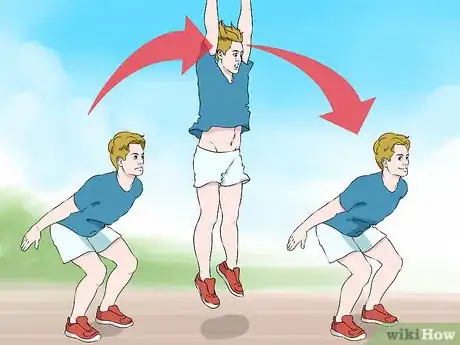



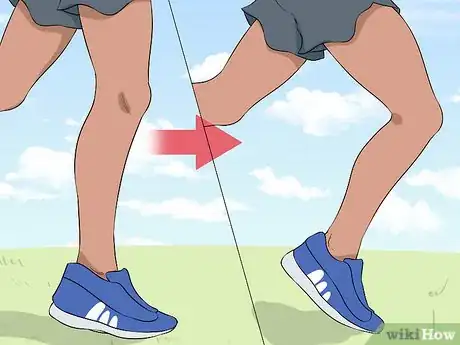
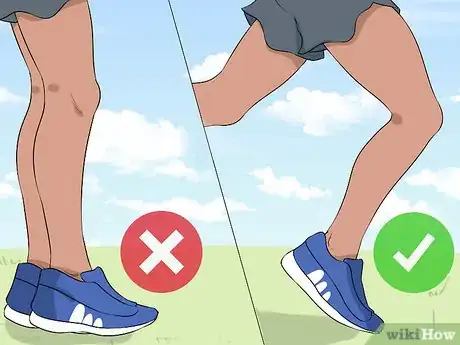






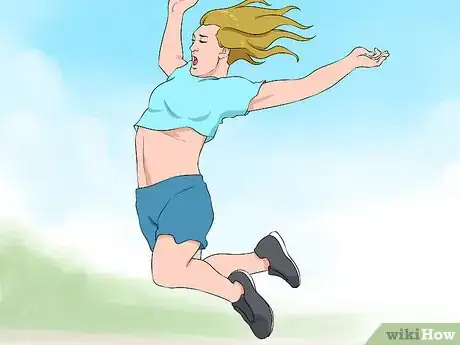
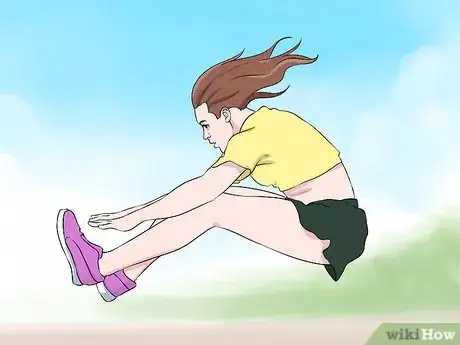
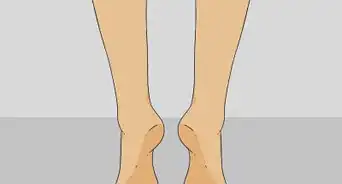

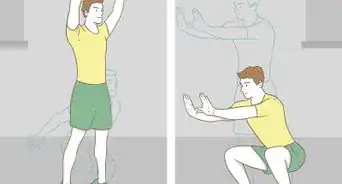


-Step-15-Version-2.webp)


